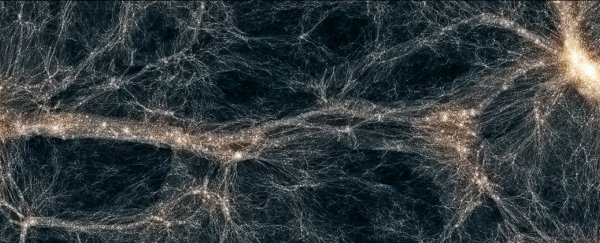According to new study, dark matter may not be as exotic as we've been led to believe. In fact, it may act remarkably similar to 'pions' - subatomic particles that were discovered back in the 1930s - and knowing this may finally help us detect the mysterious matter, which accounts for 85 percent of the Universe's mass.
Despite the fact that dark matter is predicted to be pretty much everywhere, scientists have never been able to directly observe it. This is because it's long been assumed to not interact with anything other than gravity, allowing it to travel through the Universe unnoticed, effectively in its own dimension - hence the name 'dark'. But a team of physicists led by the University of Tokyo in Japan has come up with a new hypothesis that suggests this might not be the case.
"We have seen this kind of particle before," one of the lead researchers, Hitoshi Murayama, said in a press release. "It has the same properties - same type of mass, the same type of interactions, in the same type of theory of strong interactions that gave forth the ordinary pions."
Put simply, their model suggests that dark matter does actually interact with something - itself. And if it's doing this within galaxies and galaxy clusters, it changes the predicted mass distributions of dark matter, and could explain why we haven't been able to detect it yet.
"It can resolve outstanding discrepancies between data and computer simulations," said on of the team, Eric Kuflik, a physicist from Cornell University in the US.
This isn't the first time that scientists have suggested that dark matter may not be so 'dark'. The hypothesis is backed up by a study that came out in April, which provided the first ever evidence that dark matter was interacting with itself. But the new model will help us figure out how the elusive particles could be detected in future, and how to recognise them if we do.
"The key differences in these properties between this new class of dark matter theories and previous ideas have profound implications on how dark matter can be discovered in upcoming experimental searches," said Yonit Hotchberg, a team member from the University of California, Berkeley.
Take for example the artist's impression below of dark matter distribution (white) within a galaxy. The image on the left shows all the dark matter condensed in the centre of the galaxy, as is predicted by traditional models, while the image on the right shows dark matter distributed throughout the galaxy, due to its interactions with itself:
 Kavli IPMU & NASA/STScI
Kavli IPMU & NASA/STScI
The next step is to put the predictions from the model to the test using real experiments, such as the Large Hadron Collider, Japan's SuperKEKB electron-positron collider, or the proposed Search for Hidden Particles (SHiP) experiment at CERN.
Understanding exactly how dark matter works is so important to scientists, because it's key to understanding how the Universe came to be - dark matter is crucial in forming not only galaxies, stars and solar systems, but also keeping our own bodies intact.
"It is incredibly exciting that we may finally understand why we came to exist," said Murayama. We couldn't agree more.
The results have been published in Physical Review Letters.
